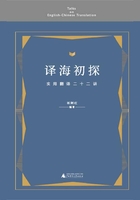
第四讲 文体与翻译
文体是翻译中不容忽视的一个大问题。泰特勒教授的翻译三原则中,就有一条是对文体的处理标准:The style and manner of writing should be of the same character as that of the original(译文的文体风格应当和原文保持一致)。后来,尤金·奈达也提出翻译要从风格方面,来重新表达原语言中的信息。
一、文体的定义
王宗炎主编的《英汉教学语言学词典》(原为《英汉应用语言学词典》,1988年由湖南教育出版社出版)中对style有两种定义:
汉语中所说的“文体”是什么?按照《现代汉语词典》,“文体”泛指“文章的体裁”。而《辞海》中对“文体”的定义:一是指“文章的风格”;二是指“语体”,即为适应不同交际需要而形成的语文体式,一般分公文语体、政论语体、科学语体、文艺语体四大类。不过,从交际功能上看,语体还可分为口语语体和书面语体两类。
二、翻译离不开文体
翻译如何体现原文风格?这就要求我们懂一点语体学或文体学。语体学通常多研究书面语言(包括文学作品,其中有书面语体、正式语体、非正式语体、非标准语体等),但偶尔也涉及口头语言(口语语体,甚至包括俚语、术语、行话、黑话等)。文体学则研究可供选择的各种表达方式。而风格的研究则不仅是作者的风格,还有民族风格、时代风格(古语体风格、现代语体风格等)。
在讨论语篇翻译的时候尤其要考虑到文体。语篇从功能上可分为表达类(expressive)、信息类(informative)和劝说类(persuasive)。
在对不同文体采取不同译法的问题上,我国翻译界就有人提出:信息类的翻译主要是译“意”,文艺类的主要是译“文”,而通知、广告类则主要是译“体”。这种说法有一定道理,但也不尽全面。因为信息类和文艺类也有“体”的问题,也有“雅”的问题。文学作品的译文,不仅应当与原作的文体一致,而且应当反映原作的文风。此外,翻译时还用到不少修辞知识(如倒装、反意、排比,渐进、突降等),这里就不专门进行讨论了。本讲浅涉书面语体、口语语体、文学语体、公文语体、应用文语体等的翻译。
三、口语语体与书面语体
口语语体的语言大量用于口头交际,它通俗活泼,其中“小词”用得多,有许多感叹词和语气词,甚至还有方言、土语、俚语等。书面语体的语言比较规范,往往使用“大词”,汉语中则表现为双音词用得多,很少使用语气词和助词。如果在口语中使用太多的“大词”,就显得太“文气”,或者说像个老夫子。在本应使用“大词”的地方如果用了“小词”就显得过于随便。此外,口语语体的句子比较短,经常出现省略和停顿,如果运用复句,则往往采用意合,省去关联词。
(一)分清是口头语言还是书面语言
从语言学的角度来看,词汇就有口语语体和书面语体词汇,如古词语、新词语、行话、隐语、俚语等。如果译得好,就可以使译文增色不少。例如,ask、show、use、find、because of、about等是在口语中使用得比较多的词,在进行书面表达时可能就成了solicit或interrogate、demonstrate、utilize、locate、due to the fact that、approximately等。如果在口头语言中使用这些书面体词汇,会给人以什么感觉呢?
汉语也一样,如“搞”字就是个口语语体的词。
但在翻译“搞好”“搞活”“搞上去”等词语时,却用了书面语体词汇。例如:
(二)语体要尽量对应
在The Congo中,有一段对大森林的描写:
The pale sun burned away the morning chill and the clinging damp mist, revealing a gigantic silent world. Enormous trees with trunks 40 feet in diameter rose 200 feet overhead, where they spread their dense leafy canopy, blocking out the sky and perpetually dripping water to the ground below.Curtains of gray moss, and creepers and lianas, hung down in a tangle from the trees;parasitic orchards sprouted from the trunks.At ground level, huge ferns, gleaming with moisture, grew higher than a man's chest and held the low ground fog.Here and there was a spot of color:the red acanthema blossoms, which were deadly poison, and the blue dicindra vine, which only opened in early morning.But the basic impression was of a vast, oversized, gray-green world—an alien place, inhospitable to man.
《刚果惊魂》的对应译文也译得比较优美:
翻译中,只要无伤大雅,就可以采取“以土对土”的办法。如果把原本土气的东西译得太文气,反而会丧失了原汁原味。请看从《美国俚语大全》上选取的一些译例。如果不犯忌讳,那就不妨把它们译成括号中的句子。
翻译时除了选择适当的词以外,还要从句子乃至语篇结构上看这个词的意思,译出说话人的语气,人物的身份、心态、受教育的情况,等等。下面是Kimball回忆儿时的一段经历,是典型的口语语体,其中还掺杂了带有孩子气的语言:
I can still remember as a little kid when I'd be out playing with the other tall children in the neighborhood and one of them would start in with the“What does your daddy do?”game. Sound familiar?
“Hey, Johnny, what does your father do?”
And Johnny would put his thumbs inside his belt, strut around for a few steps, and say:“My daddy works for the govva-mint!”
“Ooooo!”
“Wow!”
“Man!”
Then it was:“Hey, Suzie, what does your daddy do?”
And Suzie would look up, her eyes twinkling and her face beaming, and say:“My daddy, he's an enja-neer!”
“Gee!”
“Hey!”
“Neat-o!”
I knew it was coming, and it finally did:“Hey, skinny Bobby Kimball, what does your daddy do?”
And my shoulders would slump, my head would drop, and my eyes would stare vacantly at the ground.
“M-m-m-my daddy……H-h-he's just a s-s-s-salesman.”
Why is this so?What's going on?Why the bad rap for the selling profession?Let's think about it for a moment.
(AMA Handbook for Successful Selling)
我们先来看几个粗体词:
(1)tall一般译为“高”就行了,可是tall children译成“高个子的孩子们”就有点别扭,这里说到的孩子在说话者眼中个子高,译成“大孩子”似乎更合理些。
(2)govva-mint实际是government,可能是尚未上学的孩子模仿不对,也可能是方言,文中译为“京府”就是一种用近音字的处理办法。下面的enja-neer译为“功臣师”也一样。
(3)Ooooo、Hey和Wow是拟声感叹词,可以利用汉语中类似的感叹词。
(4)Man、Gee和Neat-o基本上可归为俚语。Man(an exclamation often expresses surprise or pleasure)是孩子学大人的话,用来表示惊讶,在这里可以译为“好小子”“有你的”等,gee是俚语(a mild expression of Jesus),所以可以译成“天哪”“乖乖”等,而Neat-o中的neat是俚语,意思是excellent, admirable,-o是模拟尾音,所以不妨译为“真了不起”“真棒”等。
(5)strut不是一般的行走,而是“高视阔步或趾高气扬地走”。再看skinny,把它译为“瘦子”也可以,但译成“瘦猴”似乎更符合儿童语言。其他几个词就不一一分析了。
请看完整的译文,注意其中孩子们的用语是如何翻译的:
四、书面语言的四大文体
在一般的教科书上,书面文体无外乎新闻文体(媒体上的各类新闻报道)、公文文体(信件、函电)、应用文体(应用文、合同、表格、单据)和科技文体(科技文献)四种。不过,按写作方式也可分为诗歌体、散文体(包括戏剧和小说)、政论文体、叙述文体、描述文体等。我们只选其中一部分谈一谈。
(一)信息类(广告、通知等)的译文要译“体”,也要“达”和“雅”
1.揭示语
从文体上来说,揭示语有其独特的结构,翻译往往要切合中英两种语言的习惯。英语中的揭示语多以省略形式出现。如:
(1)省略主语:
(2)省略谓语:
第一种实际上下面祈使句省略了主语:You should beware of pickpocket.第二种是下面句子省略了谓语动词:Business is done as usual和No dumping is allowed here。
也有的揭示语用直截了当的祈使句:
2.广告
一则广告一般要有标题(headline)、正文(body text)、口号(slogan)、商标(trademark)和插图(illustrations)。其中,广告词的翻译绝对是一门艺术。可口可乐的著名广告“You can't beat the feeling!”被译成“挡不住的感觉!”就很有感染力。Coca-Cola中的Coca是南美的古柯树(Coca),Cola是非洲的可乐树(Cola),把它译为“可口可乐”,实在是绝妙之极。美国后来有了Pepsi-Cola(百事可乐),中国后来有了“非常可乐”(Future-Cola)。
下面是一则百事可乐在20世纪三四十年代做的广告:
《广告英语3000句》上是这样译的:
这则广告译文的第三句为误译,其余部分既没有韵味,也没有力量,不能算好的译文。下面的译法就显得铿锵有力,像广告词:
3.告示
下面是一张贴在轮渡上的告示,翻译时需注意它的语体。
CAUTION:Passengers traveling on this ferry are cautioned against disembarking before the ferry is properly moored and the gangplank is in position. Passengers disregarding this caution are hereby informed that they do so at their own risk.Passengers are also requested to stand clear of the gangway whilst the ferry is moored.
译文:通告:乘坐轮渡的旅客请注意,渡船未停稳、跳板未到位之前,请勿下船。无视本通告者,后果自负。此外,轮渡停靠过程中请勿靠近跳板。
4.信件
中英文信件各有各的格式,如在汉语中,信封就有竖写和横写两种格式,但地址都是按由大到小的顺序连写,中间写收信人的姓名,最下面或最左边写发信人的地址;而英语中是先写收信人的姓名,然后是由小到大分行排列收信人的地址,发信人的地址可写可不写,如写,则放在信封左上位置或信封背面。
公函中的称呼有Dear Sirs(英式)、Dear Madam、My dear Sir、Dear Mr.So and So、My dear Mrs.So and So、Gentlemen(美式,不用单数)等,但切不可用Dear Miss。抬头如果用了姓(名),常见的结尾是Yours sincerely,如果没有用姓(名),常用Yours faithfully作结尾礼辞。英译汉时,dear不必译成“亲爱的”,有时可借用汉语中的旧时称谓“台鉴”“钧鉴”等,但一定要区别对象。Yours sincerely和Yours faithfully可译为“此致”或“谨此”。书信方面的套语在此就不多谈了。
汉语中诸如“您”“惠函”“赐复”“贵公司”“本公司”之类的敬辞和谦辞,在译成英语时只需用“you”“your letter”“please reply”“your company”“our company”就行了,大可不必为此而伤脑筋。英译汉时则可以借用一些套语,如“承蒙”“不胜”“贵方”“奉告”之类。
商务函电的特殊文体在此也不讨论了。
5.请柬
正式的请柬在汉语和英语里都有一定的格式。下面是一封中国留学生举行电影招待会的请柬,其中第一行为主人,第二行是受邀的客人,第三行是参加活动的内容,第四、第五两行是活动时间,第六、第七两行是活动地点,最后一行是请对方给回执的意思。

受邀客人回执的格式基本与请柬的相同:
Mrs. A.Louden Brown accepts with pleasure the kind invitation of the Chinese Students in the University School of Education to join them at a Film Evening on Tuesday, the 11thof June 1974 at 7:30 pm in the Main Hall at Thornea New North Road, Exeter.
(二)如果原文有古语体的味道,译文最好有点像古汉语
请看从小说Cain(《魔界生化人》)中选的两个例句:
例1 He smiled, amused that they had discovered the ritual:Thou shalt take a sword, a tapered blade thirty inches in length with hilt of seven inches, and polish it on the Day of Mercury at the first or fifteenth hour, and thou shalt write upon the side the divine names Yod He Vau He, Adonai, Eheieh, Yayai;that thou preserveth me in adversity against mine enemies.
译文:他微微一笑,感到很有意思,他们居然发现了这个仪式:汝须于水星日之第一或第十五个时辰,将一刃长30英寸,柄长7英寸之剑磨砺;汝须书约德赫沃赫、雅赫维、伊赫伊、雅雅伊等圣者之名于剑上;汝须于逆境中佑护我免受敌害。
例2 Depart thou infernal creation!And do not think to despise the words of the sinner who dost serve the Lord of Hosts who himself hurled ye headlong from the heights to thine infernal reckoning!
译文:走开,你这孽障!快走开,你这魔鬼!休要藐视众神之主的奴仆对你的忠告。是主亲自把你从上天打入地狱的!
(三)文学语言有其独特的韵味,尤其是诗歌
下面是一首诗及其英译,注意汉语中诗歌的押韵方式与英语中的不同:
题君山 The Beauty of Junshan
下面以毛泽东的七律《人民解放军占领南京》为例,看两位大手笔是如何译的。
赵甄陶先生译:
对赵先生所译的毛主席诗词,韩素音女士有如下一段评价:“我读过许多毛泽东诗词的外文译本,但按‘信’与‘雅’的标准来要求,还没有一种译本达到了完美的境界。赵教授这本可能是最好的译本之一。”
许渊冲先生译:
许先生译的《毛泽东诗词选》于1993年问世,许先生在译序中说,毛主席的诗词已经有11种译本,发行量之大超过了全世界任何诗人的诗集。相比之下,许译的这首诗要略为逊色些,把“紫金山”译成Purple Mountains不如译为Purple Gold Mountains更到位些。
(四)处理古汉语译成英语的问题
古汉语译成英语实际上有一个二次翻译的过程,首先要弄懂古汉语的意思,然后才能进行汉译英。如下面的古汉语,如果不知道它的意思,是根本无法翻译的:
比较合适的译文是:
A Record of Handcraft·craftsman says:“When craftsmen were building the capital, they used a rope with plummet to ensure the ground is horizontally flat and the pillars vertically upright. They used a sundial to see the length of sun shadows at sunrise and sunset.According to the shadow at noon and the position of the pole star at night, they got the right time of sunrise and sunset.”
文中的“国”指的是国都,“县”应指悬垂线,前一个“景”指日晷,后三个则同“影”。“朝夕”系指日出与日落时间。
那么,古汉语译成英文是否应当也带古英语味呢?如果是,那对大多数译者就有点勉为其难了。1998年,外语教学与研究出版社和中国文学出版社联合推出了汉英对照的Cherished danm blossoms:A Retrospective of Chinese Literature(《朝花惜拾:中国文学书系之古代散文卷》)。下面是从陶渊明的两篇散文的开头部分中选出的几句,同时选了相应的译文,为的是说明这种翻译并非人皆可为。
译文如下:
我们可以看出,译文用的不是古英语,而是现代英语,其中有解释性翻译,如“晋”(the Jin Dynasty)、“太原”(the reign of Taiyuan)、“落英缤纷”(all patterned with fallen blossoms);也有解释性添加,如in his boat;还有减词,如“甚异之”的“之”字;为求形合,译者使用了in、of、there was、when等词,而且在句子结构上也做了不少变动。
这篇散文,译者采用诗歌体来译,而且译得颇有韵味:
(五)歌词的翻译
歌词的翻译也是有一定要求的,主要是能将译文演唱出来,能押韵当然更好。现以《我的祖国》歌词的汉译英为例,看看优美的汉语歌词是如何运用意译的方式译成英语的:
本讲结束语:文体问题是翻译所面临的非常简单的问题,却是译者不能忽视的问题。这一讲虽然涉及的面很广,陈述的现象很多,但也难免挂一漏万。要想知道梨子的滋味,最好的办法还是去尝一尝,因为实践才能出真知!
翻译练习
试译下面这张质保单。
This product is guaranteed for 5 years from the date of purchase against faults in the manufacture of the materials, providing that it is used in accordance with the operating instructions;that it has not been misused;that no unauthorized alteration, modification or substitution of any part or parts of it has been made;that the serial number has not been defaced or altered.
Under no circumstances shall the Company be liable to pay compensation of damages to any person for any loss, injury, or damage whatsoever occasioned by this product or as a result of the use, misuse, or abuse of this product, whether arising in contract or in tort, and all warranty express or implied(save as above)is specifically excluded. This clause shall operate in every case unless altered or amended in writing signed by the Secretary of the Company.This guarantee can only become operative if the attached“Guarantee Registration”form is completed and posted within fourteen days of purchase to the manufacturer.
Note:The above guarantee is limited to the repair or replacement of any parts found to be defective on the return of the product within the guarantee period.